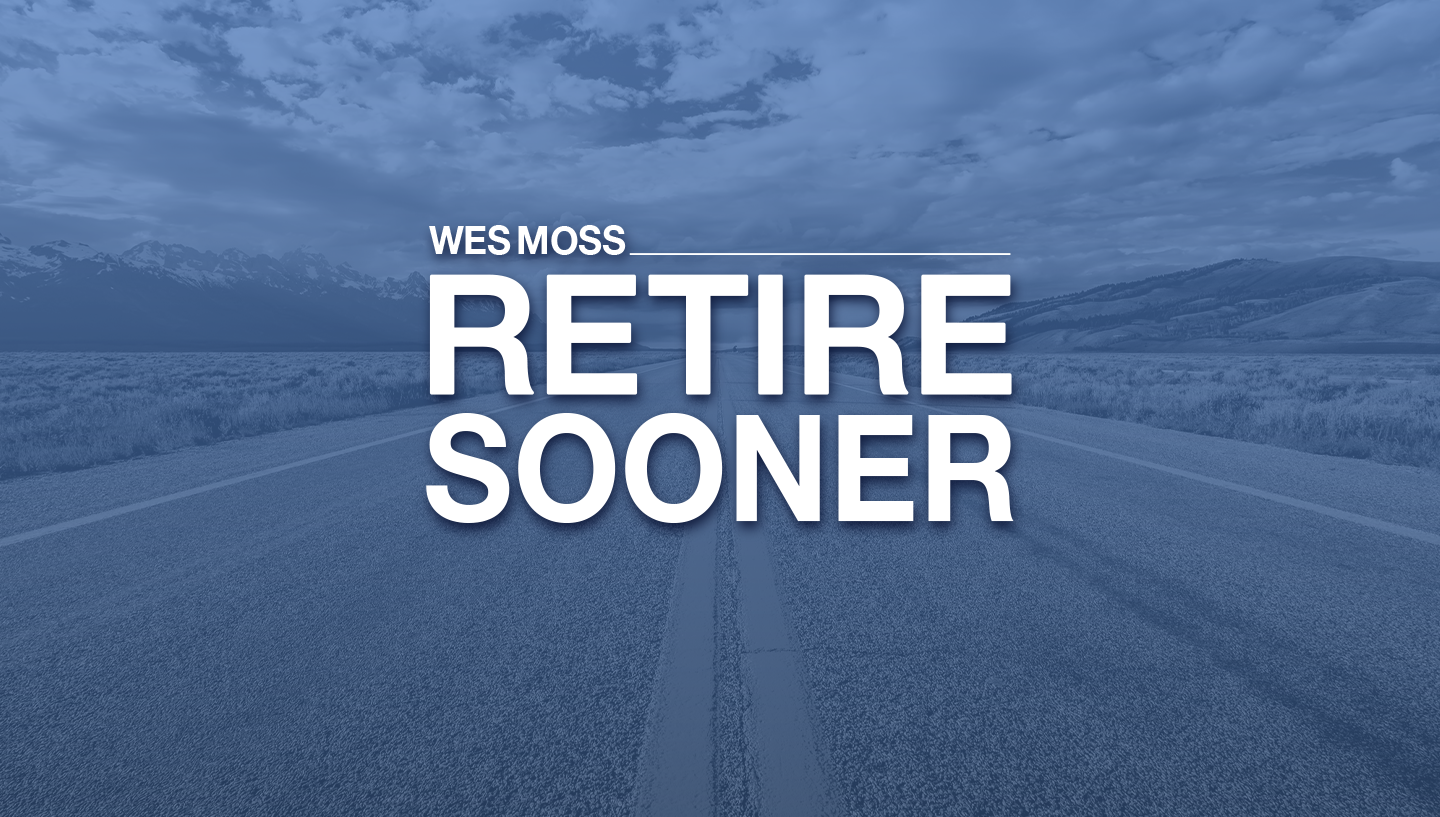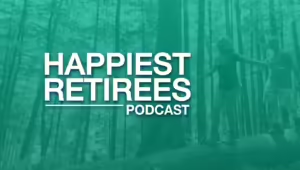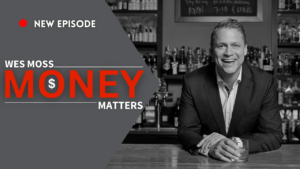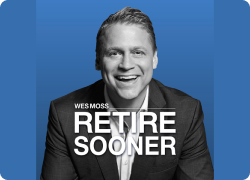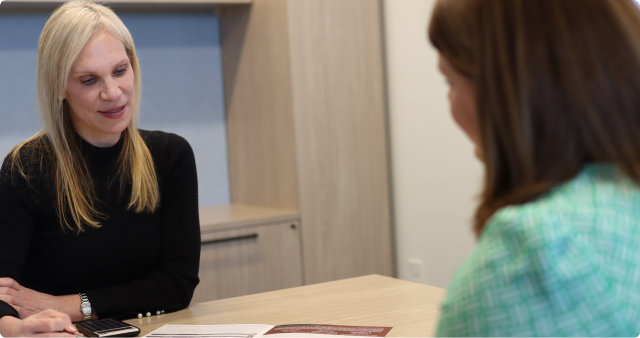Unlock secrets to increase the probability of saving more for retirement, managing risk, and making more efficient financial moves. Learn how a simple mindset shift could potentially lead to a 14% increase in savings, why your risk tolerance evolves over time, and how to structure your investments for a more secure future. Explore strategies for dry powder reserves, Roth vs. traditional 403(b) contributions, and pension buyout decisions. Get helpful insights on dividend stocks, cybersecurity for retirement accounts, and creative legal ways to bridge income gaps before claiming Social Security. Wes Moss and Christa DiBiase break it all down on this episode of The Retire Sooner Podcast.
Read The Full Transcript From This Episode
(click below to expand and read the full interview)
- Wes Moss [00:00:04]:
I’m Wes Moss. The prevailing thought in America is that you’ll never have enough money and it’s almost impossible to retire early. Actually, I think the opposite is true. For more than 20 years, I’ve been researching, studying, and advising American families, including those who started late, on how to retire sooner and happier. Now I’m bringing in my good friend Christa DiBiasee, who has worked closely with Clark Howard for many years now to answer your questions and explore what makes a happy and fulfilling retirement. My mission on the Retire Sooner podcast is to help a million people retire earlier while enjoying the adventure along the way. I’d love for you to be one of them. Let’s get started.Wes Moss [00:00:50]:
Wes Moss along in studio with Christa DiBiasee.Christa DiBiase [00:00:55]:
Christa, I am so happy to be here, Wes, and I’m really excited about today’s show because you have a couple of awesome topics. So you’re going to talk about how we can save. There’s a secret to saving more for retirement. Is that right there.Wes Moss [00:01:07]:
There is. There’s psychological tricks.Christa DiBiase [00:01:10]:
I like that. And then you’re also going to talk.Wes Moss [00:01:12]:
About risk tolerance and how that changes over time.Christa DiBiase [00:01:15]:
Okay.Wes Moss [00:01:16]:
And I found a really cool study on that, so it prompted me to. I think it’s an important topic.Christa DiBiase [00:01:21]:
Okay.Wes Moss [00:01:21]:
Yeah.Christa DiBiase [00:01:21]:
Especially these days.Wes Moss [00:01:23]:
Especially these days. And risk tolerance. So let’s start by the. Think about your future self for a minute. And this is a secret. We got this from some researchers from Indiana University and UCLA researchers. So we’ve got some Hoosiers and we’ve got some Bruins. So some corn, something about corn and something about bears.Wes Moss [00:01:45]:
And these two universities put a lot of work into figuring out how people can save more for the future. The future. Something like this was interesting. When you’re asked to think about the future, 80% of us start by thinking about today. We immediately start thinking about today. And it’s really hard to visualize into the future, but if we can do that, it might really help us saving. There’s another piece of this. And psychologists call this the going home effect.Wes Moss [00:02:19]:
Think about your last trip, too. I was thinking I had to drive to a sporting event for one of my kids. Had to look up the high school in the map. I’d never been there. And it was, let’s call it an hour away. And I’m driving up to this north Georgia county that hadn’t been to. Hadn’t been to this high school. And it took about an hour, and it just felt like it took forever to get there.Wes Moss [00:02:44]:
And it wasn’t just because Atlanta traffic, it did took an hour. But do you ever notice though, then when you come home, it feels like, it feels like a quicker drive?Christa DiBiase [00:02:55]:
Of course. Yep, they’ve done that.Wes Moss [00:02:57]:
Yeah, that’s a way quicker drive. And again, I’m not saying because there was less traffic, it still took about the same amount of time. But we know as we’re going home and that psychological component gives us less uncertainty. I know where we are and I know where I am and I know. So that’s called the going home effect. And, and when we have a little bit more certainty, we think clearer, we’re calmer, we have less worry about it and we act more rationally. We know that we’re scared and we’re uncertain and we’re frazzled. We don’t make great decisions.Wes Moss [00:03:29]:
That’s just life. It’s not just in finance, it’s just life in general. So how do we trick ourselves into saving more? Because the problem with savings is it’s not ever really that urgent. And it’s so far into the future, it’s like going to this high school that it’s really far away. It’s hard to think about it. So that’s one of the biggest challenges that we all face when it comes to saving for retirement. Way out in the future, do I really have to do all this work today? It’s not going to pay off for 30, 40 years. It’s hard for Americans to do that.Wes Moss [00:04:03]:
So these researchers from UCLA and Indiana University did a whole bunch of different experiments and different tricks and different prompts on trying to see what help move the meter in convincing people or helping people save a little bit more. And one of their experiments, they stumbled across this and they did this with the customers of a Swedish fintech company. So it was, I don’t know the name of the company was a company that again, think of a brokerage company or retirement planning company. To this participant base, 6,700 people. Every time it was time for them to either look at their percentage savings or put money away, they asked them this question. They said, picture your Future self in 2035 and now adjust what you think you should be saving for your future self. What are you going to be doing in 10 years? That moved the participants on average to save 14% more in long term assets. 14%, that’s like a game changing number into long term investment assets as opposed to cash.Wes Moss [00:05:17]:
So they went through all these ways of trying to trick yourself to do this. And this is what worked. I see this in the Harvard study. It’s called the Retire Without Regrets. The retirees that were the happiest drew out a colored pencil little roadmap of what they’re going to be doing in five years or two years or three years. And the ones that did a better, more comprehensive job on that ended up being happier in retirement. So it kind of comes back to trying to crystallize or visualize. And this is, I think, where any sort of financial planning, whether it’s at the dinner table with you and your spouse, whether it’s at the financial advisor, the act of sitting down and talking about it for an hour, hour and a half and drawing something out is so powerful.Wes Moss [00:05:57]:
It sounds like, what’s the big deal? I’m going to draw out what I’m going to do in the future. I’m going to ask myself what, what my future self should be doing. Well, look, athletes have coaches and they do a lot of visualization because it works. And we can do the same thing when it comes to retirement. So if you think, take this newly discovered research is that visualization of what you want to be doing in 10 years really helps up the ante when it comes to how much you’re going to save. And I think it’s important and it’s not some, you’re not going to some crazy sweat camp retreat to figure this out. This is just dinner table across the desk. Visualize and it helps.Christa DiBiase [00:06:38]:
I love that. Okay, Javier in Colorado has a question going back to last week’s dry powder segment.Wes Moss [00:06:45]:
Would you say Javier maybe or is it Javier?Christa DiBiase [00:06:48]:
Okay, I’m not. Sorry, I’m not sure. I hope I’m pronouncing it correctly. Javier, question for Wes. Please provide a strategy for three years of dry powder. Right now I have my money in Schwab Value Advantage Money Investor shares. I’m 71 years old and, and retired. I love the book what the happiest retirees know.Christa DiBiase [00:07:08]:
10 habits for a Healthy, Secure and Joyful Life. Thanks.Wes Moss [00:07:11]:
Thank you, Javier. Dry powder can be a lot of different categories. It doesn’t have to just be cash, cash that’s sitting there with no interest. It can of course be seeded. Anything that is relatively safe compared to stocks and real estate and other assets that have prices move a bunch and it doesn’t mean prices don’t move some. But bonds really fill this category and there’s a bunch of versions of that. So of course CDs, of course cash money markets count high quality US bonds that are not super long term dry powder doesn’t count. Super long term bonds because they can move a lot in price.Wes Moss [00:07:47]:
So I would say intermediate to some extent counts, but really intermediate to shorter term bonds. Government, municipal, corporate bonds. What doesn’t count would be high yield bonds or junk bonds. They act a little bit more like stock. So think of your dry powder can have a lot of different components to it and to me that all counts. Remember, we want three years worth of the spending need beyond your guaranteed income sources. And you can really round that out with some diversification.Christa DiBiase [00:08:15]:
Great. This came in from Jeff in Georgia. I’m 44 and I’m currently and consistently putting 15% into my company’s 403B. I just happened to notice when I was looking at the account that they offer a Roth 403 in addition to the traditional 403B. I’ve been putting money into this 403 for almost 21 years. It’s the first company I was hired with after leaving the Navy in 2004. Just looking around online, I figured out that the Roth is post tax and traditional and pre tax. But I don’t know if I should put money into the Roth 403.Christa DiBiase [00:08:49]:
Should I put half of what I’m currently putting into the Roth 403 and the other half in traditional or should I put the full 15% into the Roth and transition away from the traditional or just keep everything going to the traditional? My company matches up to 3% of what I put in, but they also have a pension that I’m enrolled and invested in. Wow, look at you. A lot of you don’t have that anymore. I’m just trying to figure out what kind of retirement account would be best. Any sort of insight would be greatly appreciated.Wes Moss [00:09:18]:
Jeff. To Roth or not to Roth. To Roth 401k or not? Roth 401k regular 401k? That is a tough question and I don’t know if there’s a perfect answer here. What I would tell you is, first of all, he’s been saving. Jeff, you’ve been doing 15% for 21 years. In my opinion, that’s 90% of the battle. The other 10% of the battle is figuring out which account is better. Now, you already have a ton.Wes Moss [00:09:41]:
It sounds like you already probably have a lot in the regular 403B. The choice of a Roth or not or regular. There’s advantages and disadvantages to both, so you can argue either. But primarily, the lower the tax bracket you’re in today, the more likely it’s better to do the Roth 401K. If you’re in the 37% bracket and you’re making a ton of money right now that you get a big deduction, well, you get a big pre tax advantage by using the regular 401k lowers your overall tax rate. In fact, if you do a bankrate has a calculator on this, it’s a.Christa DiBiase [00:10:15]:
403B, but I know that doesn’t matter, right?Wes Moss [00:10:17]:
403B, 401K, Roth, 403B, 401K, they’re somewhat synonymous, very, very similar. But if you were to go and look at a calculator where you’re trying to figure out the answer to this question, if you check the box that is I’m doing a regular 401k, 403 and I’m getting the deduction, but I don’t get the tax free nature of it eventually when I I’m starting to withdraw money. If you check the box that says you take what you’ve saved by using the regular 401k because remember this is pre tax dollars and you invest that as well, your net almost always, from what I can tell in these calculators, you should mostly always win and that’s the better strategy. But very rarely do folks say, oh, I’m saving $6,000 because I’m lowering my taxes by using the 401k, I’m going to take that 6,000, invest it and that’s going to grow over time. So that’s one way I would look at it is if you are doing this and you’re quote saving money, you want to reinvest technically the savings as well. But if you’re in a high bracket and again, 32%, 37% and when in retirement you’re only going to be in the 15% bracket, then I lean towards keeping traditional 403B contributions. But if you’re in a moderate, call it the 24% bracket and even and lower makes this even better, then I would do the Roth.Christa DiBiase [00:11:48]:
It also can kind of force you if you’re not someone who’s going to take the extra money and invest it. If you were going to put 6,000 in and you can still put 6,000 in post tax, you’re kind of forcing yourself to actually save more money because you’re paying the taxes on it and you’re still, you know, it’s another cool.Wes Moss [00:12:04]:
Way to think about the Roth. But it really is, it’s all about taxes today versus tax tomorrow. And for most people, the Roth retirement plan option does make a lot of Sense, unless you’re in a super high bracket. He also has a ton of money. He’s already saved in the regular. So if you want to start to try to get that balanced, your Roth is here and your traditional is here. I would lean towards probably doing more in the Roth. And you could always split it.Christa DiBiase [00:12:33]:
Sure. Steve in Minnesota wrote in with this one for you. Wes, please help me wrap my brain around two different percent rules that you have discussed. First is a retiree can withdraw about 4% of their saved funds each year and typically have the funds last all of their retirement. Second is the evaluating lump sum pension buyout versus annual pension and the rule that if the annual pension is greater than 6% of the lump sum, then take the pension. If a pension wants the lump sum to last all of their retirement, then why is the decision point not at 4%?Wes Moss [00:13:08]:
So he’s saying, wait a minute. Why do you use six for one rule and four for another?Christa DiBiase [00:13:14]:
Right.Wes Moss [00:13:15]:
Man, nobody’s ever asked me that before. So I guess I have to have an answer for that. There’s a really. I think there’s a very simple explanation here, is that the 4% rule, and this gets missed, the 4% rule accounts for inflation. The 6% rule doesn’t. Okay, the 4% rule is about your own money and making it last. The 6% rule is not your money. It’s the pension promising to pay you.Wes Moss [00:13:47]:
And you have to be alive to get it. That’s why those two numbers are so different. And they’re different, but the calculations and how we came up with these, they’re taking into account some majorly different variables. One, it’s your own money and accounts for raising the amount every year for inflation. Pensions. By and large, most pensions, not all, but by and large, most pensions do not give you a cola. It’s a set amount, doesn’t go up. And again, it’s not your money.Wes Moss [00:14:15]:
And you got to be alive and or your spouse to get it. And that’s why those are two completely different scenarios and why one’s four and one’s six. That’s a cool question.Christa DiBiase [00:14:26]:
You have an answer for everything. I love it. Okay, coming up next, we’re going to talk about risk tolerance and historical risk.Wes Moss [00:14:34]:
Tolerance changes over time.Christa DiBiase [00:14:35]:
Yes.Wes Moss [00:14:38]:
Are you facing a fork in the road and deciding between continuing your career and retirement? I’m Wes Moss, and this massive life decision shouldn’t be taken lightly. Talk with my team. If you’d like help reviewing your retirement accounts and building a financial plan, we can help you review options and offer an opinion based on your best interests. You can find us@your wealth.com that’s why o u r wealth.com we wanted to go into changing risk tolerance.Christa DiBiase [00:15:11]:
Right, right again.Wes Moss [00:15:12]:
How do we come up with these topics? It’s usually something I read or a chart. I love finding new charts and it’s.Christa DiBiase [00:15:18]:
You love a chart?Wes Moss [00:15:19]:
I love a chart and a table. A heat map. Oh, one of this. We actually have a heat. I want to talk about a heat map too. But this was a JP Morgan publication I believe and they had this really interesting chart and they used different colors for the percentage of how likely or how self identified you were aggressive to conservative on a time continuum. So if I’m 30, what do most people put? Are they aggressive, moderately aggressive, moderate, moderately conservative, conservative all the way out to age, call it 80 or 90. And.Wes Moss [00:15:53]:
And it’s an interesting shift according to the research. Meaning that. And I’d say I want to frame this in thinking. I think I call this from being bold to being balanced. And what we see empirically is that people shift their risk tolerance over time. I think that makes sense. You start out more aggressive and then you migrate to becoming more conservative. What a little bit interesting is that in the 30 year old category there’s actually a fairly big chunk of folks that are in the conservative group.Wes Moss [00:16:26]:
Even though you’re in your 30s and you’ve got a forever time horizon, there’s still a higher amount of folks that are in the conservative leaning group, conservative safe investments than there are people in their 40s. And it’s because I think you’re starting out even though we’d say you start when you’re 20. Most people don’t start investing till they’re in their 30s and or 40. So you do tend to see there’s a bigger contingency or a higher propensity when you’re starting out to be a little more cautious. Hey, I haven’t been investing for a long time so I want to keep money just in cash. I get it. Then we see again empirically that risk tolerance peaks at around age 55. So you see the most people that identify themselves as aggressive, moderately aggressive, moderate investors, and the fewest in the conservative camp.Wes Moss [00:17:17]:
And then by around age, call it 55, you start seeing the conservative group start to really jump. And of course that keeps going in 60s, 70s and 80s as people add more balance or more conservative pieces or ingredients to the overall investment pie. So that is what the data says and that’s what I see in real Life, it’s natural. As you get closer to retirement, you start thinking, wait a minute, I’m not going to get a paycheck anymore. So I really can’t have my entire portfolio go down by 20 or 30% if I’m all totally invested in stocks. So that begs the question of kind of where do we want to be as a guideline per age? Now I will say this, even though I love rules thumb. There is no one size fits all on what your allocation should be for your age. When you’re, if you’re 30 or 40 or 50, there’s no exact, there’s nothing to tell you what works.Wes Moss [00:18:13]:
Now the way I think about this is I go back over market history and look at economic data, market data. I think about some of the really important financial planning rules of thumb and then I think about just behavioral finance and investment behavior. And I think if you look through that lens, you can start to get an indication of approximately where most people should be at a certain age. And this is how I would look at it. I think if you are in your 20s through 40s, that’s early career, still super early career and you still have a super long time horizon. That’s the time that you want to be arguably 90% in stocks, 100% in stocks, provided you still have some emergency money, some liquid money to get to. So that phase very simply is mostly in equities. This is where corrections, bear markets dips, you name it.Wes Moss [00:19:12]:
That’s your friend. During that period of time you want the market to dip because your dollar, you should be investing regularly, AKA dollar cost averaging. You’re smoothing out your purchase price over time. Then you get to, I would call it the next phase, Christa, the 40s to the 60s. That’s where you want to start to enter into balance. Now this may be 25, 30% into safety assets, maybe more depend again depending on your risk tolerance. But you still want to have the majority of your investments in longer term assets that can keep up or beat inflation over time. I think it’s when you get to your 60s, you get into your 60s, that’s when you really want even more balance.Wes Moss [00:19:54]:
Call it 40% in bonds potentially. And then of course your 70s, that’s when that number increases. Now there’s a caveat to that is the financial planning rule of thumb. This is the heat map I was talking about. JP Morgan also did a heat map that showed the different withdrawal rates from 1% withdrawal rate all the way up to a 10% withdrawal rate and paired that with different allocations from all in bonds or cash, all in stocks, and then everywhere in between. Between to try to figure out what gave you the highest probability of never running out of money. Well, of course, the 1% withdrawal rate didn’t matter.Christa DiBiase [00:20:35]:
Right.Wes Moss [00:20:35]:
You never run out of money. You’re leaving everything invested. 2%, same thing. 3%, same thing. But of course, 10% and 9% and 8% and 7%. Almost in every scenario, people run out of money with a high confidence of running out of money. It’s the opposite of what we want when a high confidence of never running out of money. So on the heat map, of course, the 1%, 2%, 3% withdrawal rate, that’s in the green.Wes Moss [00:20:59]:
Then you got the red and the high withdrawal rate. So where do you find some sort of happy medium? And this goes back to this concept of we want to be able to max out our withdrawals without running out of money. And that goes to the 4% line. That’s where the heat map kind of has some different coloring, but with still a really high probability of not running out 90 to 95% of the time. Money doesn’t run out for 35 years. That’s what they did in the study, and that’s with a balanced half stock, half bond portfolio. So as we change our risk tolerance over time and we get more conservative, I think for most folks, if you’re really having to withdraw money, you don’t want to go beyond 50% in bonds in most cases. And I think that that gets lost in the idea of you look at some of these target date funds, and when somebody’s in retirement or a few years into retirement, it’s 60, 70% in bonds.Wes Moss [00:21:54]:
I just think that gets too conservative. It doesn’t apply to the 4% rule. You need to have that 50% in equities in order to be able to keep up with inflation.Christa DiBiase [00:22:04]:
Okay. All right, I’m going to give you some questions now. This came in from Bonnie in Ohio. I’m 64, retired. I retired at 62, and I have a net a pension of $3,900. My husband will be 68 in October. He retired in 2024, and he’s trying not to take Social Security until he is 70. Social Security would be 3363 at this time, and at 70, it’d be over $4,000.Christa DiBiase [00:22:30]:
We have just paid off our mortgage, and we have $500,000 in equity and $800,000 combined. In our 401s, we have a car payment of $550 at just over 5%. Four years to go. That is our only bill. We lived on savings for his first year of retirement. We have a HELOC at 6 1/2 percent. It’s $100,000 of available credit. My thinking is to live off the HELOC until my husband can take Social Security and let the 401k continue to grow.Christa DiBiase [00:23:01]:
I have everything in a target retirement fund for 2030. I know I can access those funds if I need to. I don’t think we’ll need additional support once he starts collecting Social Security. And I’ll collect my own at 70 as well. I feel pretty good about those numbers since it puts us in the same income to expense ratio as when we worked. So does using the HELOC make better sense than pulling from the 401k?Wes Moss [00:23:25]:
Hmm. Bonnie, that’s a good one. A lot of variables. I’m writing these down.Christa DiBiase [00:23:31]:
Lot of numbers.Wes Moss [00:23:31]:
So $3,900 in pension. Husband 68. Bon has she. He wants to wait two years to get to his full social at age 70. Mortgage paid off, 800,000 in savings, $550 car payment. What I can deduce here, I’m deducting that they don’t need that much money because the HELOC 100 and they could. That could bridge the gap for two years. That means she probably has less than 50,000 of a need.Wes Moss [00:24:02]:
And that’s important here because, first of all, it’s an interesting idea, right? I mean, if you said The HELOC was 12% interest, it’s no way. Bonnie, that’s crazy. Don’t use the HELOC. Just judiciously pull money out of the 401k. Don’t even mess with the HELOC. It’s in kind of that heat map zone. It’s not red hot bad, it’s not green. Let’s go.Wes Moss [00:24:22]:
It’s kind of somewhere in the middle. 6.8%, I think. So it’s a high rate, but it’s not crazy high. And it intuitively does make a little bit of sense to utilize that bridge the gap because what is she doing? She’s keeping her tax rate low because pulling money from the heloc, that doesn’t go towards your tax rate. So you’d be in an ultra low tax rate at the same time. The problem, I think, Bonnie, this is just my opinion. I think it comes on the back end. Okay, we gotta pay the HELOC off.Wes Moss [00:24:55]:
Mortgage is already paid off. Now you get 100 plus thousand dollars in HELOC. Well, if you want to get rid of that 6, almost 7% interest, where’s it going to come from? Well, yes, you’re going to be getting some Social Security coming in, but that’s a bigger bill to get rid of it quickly. So the money’s got to come out of the 401k anyway. And if you do that in a big chunk, then you have a lot of income in one year and your tax bracket goes up and you pay a lot more in tax taxes. So it makes sense intuitively. And I think if it was a small amount, I could see how that would work and it wouldn’t impact your taxes. But.Wes Moss [00:25:29]:
So I love. I really love that idea. But I don’t love when the payback phase comes because I feel like it could get you into a tax vortex of pulling a bunch of money out of the receiving account. So I would lean towards not doing it and just judiciously taking just what you need out of the 401k. If it’s only 40 or $50,000 and the only other income is the pension. Right now, I think, Bonnie, you and your husband are still in a pretty low tax bracket, so it’s not a ton of taxes. The rate shouldn’t be that high anyway. So that’s how I would play.Wes Moss [00:26:03]:
This is just take just the bare minimum you need out of the 401 to supplement. I don’t think I’d mess around with the heloc, but I think it’s actually a really smart idea.Christa DiBiase [00:26:12]:
Okay. This is from Caroline in South Carolina. I’m concerned about my IRA accounts, which are held at the same brokerage as my checking account. Is my retirement at risk if a scammer gets hold of my bank account information? Should I move my retirement funds to a different brokerage than my checking?Wes Moss [00:26:29]:
Caroline, look, we are all worried about this, and rightfully so. I mean, there’s thousands or millions of cyber attacks literally every single day. And the big any bank, and particularly the large brokerage firms, have entire cybersecurity teams that are monitoring every transaction. Try to minimize this and cut it down to as low as humanly possible. I don’t see any reason that having brokerage firm A with a bank account at the bank division of brokerage firm A is any less safe than having brokerage firm B and a bank account at brokerage firm A. I don’t see any. I don’t think you need to do it. I am totally fine to have an investment account at one place and also have a Bank account at another.Wes Moss [00:27:18]:
It really goes back to the cyber vigilance. It’s two factor authentication. It’s checking your accounts on a regular basis to make sure nothing’s happening that’s out of the ordinary. And strong passwords. I think if you can really continue to do that, that to me is much more effective and more important than trying to spread out. Bank here, brokerage here, bank here, brokerage here. Totally fine to have a couple different bank accounts. I get that I’ve got more than one banking institution, but I don’t feel the need to do that from a cyber perspective.Christa DiBiase [00:27:50]:
Okay, and this came in from Gail in Vermont. Question for Wes. Can you explain the benefits, if any, of investing substantially in dividend stocks and ETFs as opposed to the more commonly recommended equity index funds and ETFs, target date funds, et cetera? My YouTube feed seems to be full of channels promoting too good to be true monthly income streams from this investment strategy. What am I missing?Wes Moss [00:28:15]:
Gail in Vermont? The too good to be true. You didn’t give me a number on that, but I would just expect that’s 10% a year. Income is probably an ad she saw and that is too good to be true.Christa DiBiase [00:28:28]:
And then you get more because you’re in the algorithm.Wes Moss [00:28:32]:
So Gail’s been looking around for income producing stocks. The other thing I probably should have mentioned in the thought around the changing risk tolerance. Remember, the stock continuum is really, it’s a giant continuum, meaning you’ve got some stocks that are aggressive and super volatile, high beta stocks, and then you’ve got low beta stocks. And that goes into this conversation around dividends. If you’re in an index fund cap weighted, then if you look at the S&P 500 right now, it pays collectively. The dividend on the whole market is about 1.3%. And that’s important because dividends are in order to call something a dividend stock. It’s all relative, right? If The S&P 500 has a dividend of 2 1/2% and over time, I mean, if you go back to 1980, the dividend on the SP 500 was five and a half percent.Wes Moss [00:29:23]:
So what was the dividend stock? The dividend stock then was a 7 or 8% yielder. It’s all relative. Today you got a ton of big companies that dominate the S&P 500 that are technology based, that are not known to pay a whole lot in dividends. If you look at the tech sector, they pay less than 1% on average. So a lot of those companies pay zero in dividends. So to have a dividend stock, it’s relative. I would say a dividend stock to call. And this is subjective.Wes Moss [00:29:51]:
There’s not a, there’s not a perfect black and white answer or definition here. But for me, a dividend stock in today’s world, it has to be at least 2% and that’s pretty low. And you can easily find that. You look at the utility sector, a lot of those companies are closer to three. The oil sector or energy sector, it’s well over three. Those are dividend stocks in the world we live in today. So to have anything beyond call it 4% or 4.5% as a dividend, you’re running into a lot more risk. And there are lots of things that pay 7, 8, 9, 10% where you’re going to likely suffer.Wes Moss [00:30:30]:
There is on the, on the value side. So remember, we’re all after TR equals gi. Total return is growth plus income. So you can, if you have a huge number on the income side, then there’s probably something wrong with the growth side. I think when you’re looking for dividends, then that’s where I want to look at kind of a Goldilocks zone, not too low. So 1 or 0 to 2% is probably a little low. To call it a dividend stock, you’re probably looking at 2.25% to 4%. That to me is the Goldilocks zone.Wes Moss [00:31:05]:
For companies that pay out steady cash flow, I think that that becomes more and more attractive to folks as we change our risk tolerance over time. Note that dividend paying companies are usually more mature. They’re slower growing, so they have a lower G and a bigger I. A younger technology company that’s growing gangbusters will have a bigger potential for G growth and they’re not paying out any dividends because they’re not. They’re still a newer company and all the money’s going back to reinvest for growth. So as we go from the continuum of high growth, no income to a more mature, slower growth, higher income, that continuum can be attractive as we get closer to retirement. Again, these are styles of investing. There’s no perfect answer, right or wrong.Wes Moss [00:31:52]:
I think a lot of this goes back to our risk tolerance. Right As I get into retirement, I’m a little less okay with huge swings in my stock portfolio. One way to do that is reduce stocks. Another way to do it is change and modify the kind of stock. And big indexes are typically going to be weighted towards the big players. Right now big players in the market or big sized companies that dominate are much more weighted towards tech, high growth, low, low dividend, low income. So just note that as you do some of this planning, but it always gets back to if there’s anything that’s 10% rate of return in income. That’s something that usually doesn’t last.Christa DiBiase [00:32:34]:
Yeah, Gail was right on with her. It’s probably too good to be Galen.Wes Moss [00:32:37]:
Vermont is right on the money. Thank you G Chris, I love having you here. I love these questions. So thank you as always for being in studio. Send us More questions@yourwealth.com contact. Have a wonderful rest of your day.Mallory Boggs [00:32:53]:
Hey y’all, this is Mallory with the Retire Sooner team. Please be sure to rate and subscribe to this podcast and share it with a friend. If you have any questions you can find us@westmoss.com that’s w e s moss.com. you can also follow us on Instagram and YouTube. You’ll find us under the handle Retire Sooner podcast. And now for our show’s Disclosure this is provided as a resource for informational purposes and is not to be viewed as investment advice or recommendations. This information is being presented without consideration of the investment objectives, risk tolerance, or financial circumstances of any specific investor and might not be suitable for all investors. The mention of any company is provided to you for informational purposes and as an example only, and is not to be considered investment advice or recommendation or an endorsement of any particular company.Mallory Boggs [00:33:40]:
Past performance is not indicative of future results. Investing involves risk, including possible loss of principle. There is no guarantee offered that investment, return, yield or performance will be achieved. The information provided is strictly an opinion and for informational purposes only, and it is not known whether the strategies will be successful. There are many aspects and criteria that must be examined and considered before investing. This information is not intended to and should not form a primary basis for any investment decision that you may make. Always consult your own legal, tax or investment advisor before making any investment, tax, estate or financial planning considerations or decisions. Investment decisions should not be made solely based on information contained herein.
Call in with your financial questions for our team to answer: 800-805-6301
Join other happy retirees on our Retire Sooner Facebook Group: https://www.facebook.com/groups/retiresoonerpodcast
This information is provided to you as a resource for educational purposes and as an example only and is not to be considered investment advice or recommendation or an endorsement of any particular security. Investing involves risk, including the possible loss of principal. There is no guarantee offered that investment return, yield, or performance will be achieved. There will be periods of performance fluctuations, including periods of negative returns and periods where dividends will not be paid. Past performance is not indicative of future results when considering any investment vehicle. The mention of any specific security should not be inferred as having been successful or responsible for any investor achieving their investment goals. Additionally, the mention of any specific security is not to infer investment success of the security or of any portfolio. A reader may request a list of all recommendations made by Capital Investment Advisors within the immediately preceding period of one year upon written request to Capital Investment Advisors. It is not known whether any investor holding the mentioned securities have achieved their investment goals or experienced appreciation of their portfolio. This information is being presented without consideration of the investment objectives, risk tolerance, or financial circumstances of any specific investor and might not be suitable for all investors. This information is not intended to, and should not, form a primary basis for any investment decision that you may make. Always consult your own legal, tax, or investment advisor before making any investment/tax/estate/financial planning considerations or decisions.

